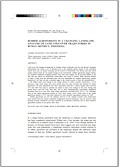| Journal Article |
 |
|
| Article Title | Rubber agroforests in a changing landscape: analysis of land use/cover trajectories in Bungo district, Indonesia | | Author | Andree Ekadinata and Gregoire Vincent | | Year | 2011 | | Journal Title | Forests, Trees and Livelihoods | | Institution | A B Academic Publishers | | Volume | 20 | | Pages | 3–14 | | Call Number | JA0407-11 | | Keywords | land cover change, drivers of deforestation, rubber agroforests, Indonesia |
|
| Abstract: |
| Land cover has changed dramatically in Sumatra Island, Indonesia over the last decades. Rampant deforestation has drawn a lot of attention due to the potential global impact of the associated carbon stock loss on climate warming and the erosion of biodiversity. The various land uses which replace natural forest are not equally benign to the environment. Rubber agroforests (jungle rubber) are extensive traditional cropping systems. They have been singled out by previous studies as the best land use option for biodiversity conservation once forest is cleared, while allowing farmers to make a living from the deforested land. But how sustainable are complex agroforestry systems themselves? Are they not just a transient stage in the overall process of land use intensification?
We studied land cover change in the Bungo district, in Jambi, Sumatra (Indonesia), a 4,550 km2 area. Large forest tracks have been cleared since the early seventies and replaced by rubber plantations, oil palm plantations and other agricultural land-uses. Landsat images taken between 1973 and 2005 were used to quantify the trends of land cover changes in the area. During that period forest cover fell from more than 75% to 30%. Simultaneously monoculture plantations increased from 3% to over 40%, while rubber agroforests, decreased from 15% to 11%. Strikingly most of the rubber agroforests present in 2005 where absent in1973 while most of the rubber agroforests present in 1973 had been replaced by more intensive agricultural systems by 2005.
Rubber agroforests are now the ultimate reservoir of the original lowland forest biodiversity since natural forest has almost completely disappeared from the peneplain. They are however under growing pressure themselves and have incurred an accelerated conversion rate to more intensive agricultural systems in the period 2002–2005. |
|
|
Download file(s): Click icon to download/open file.
|
|
|
|
|
| Viewed in 2363 times. Downloaded in 0 times. |